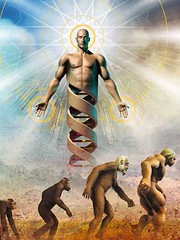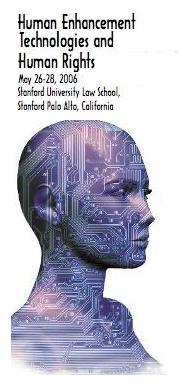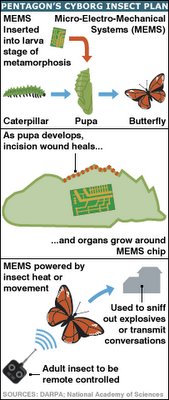 More than just a philosophy and social movement, transhumanism is for many a way of life
More than just a philosophy and social movement, transhumanism is for many a way of lifeBy George Dvorsky, November 10, 2003
Some experts believe that all genetic-based diseases will be eliminated by 2030. The widespread application of genetic and other technologies, it is thought, may also result in significant increases to human intelligence, memory, physical health and strength. Some expect the achievement of indefinite lifespans this century and believe that immortals already walk among us.
Researchers suspect that the development of strong nanotechnology in the coming decades will result in molecular assemblers that effectively function like Star Trek replicators. A number of experts are hopeful that medical nanotechnology will be used to revive those who are preserved in cryonic stasis. It is also suspected that advances in both nanotechnology and robotics will greatly alter the current socioeconomic infrastructure, potentially resulting in such things as massive unemployment, the need for a basic guaranteed income, and the general rethinking of how people should coordinate their activities and leisure time.
Steady advances in computing processing power are leading many experts to conclude that human-equivalent artificial intelligence may be attainable by the year 2040, if not sooner. After that, as intelligent machines continue to redesign themselves and recursively improve, they will likely develop into superintelligences, with cognitive capacities thousands of times greater than that of humans. No one knows what this will mean to humanity, causing futurists to dub the hypothesized event the "technological singularity," or simply the Singularity.
These predictions are nontrivial to say the least. Of course, they are just predictions, and most casual observers maintain that these things will never come—or at least not within their lifetime. Futurists such as myself tend to be less skeptical, recognizing the remarkable upward trends in technological research and development; things are set to change quite dramatically and quite quickly.
In consideration of these predictions, a growing number of people are turning to transhumanism, which aims to promote and encourage human enhancement through the application of science and technology. They maintain that this is a good thing, and that we should encourage and work towards the attainment of a posthuman condition.
While many—including me—have written often about transhumanism, few have elaborated on how the transhumanist mindset has an impact on how people live their life in the present. Not ones to dwell on the future while passively waiting for it to happen, transhumanists engage in foresight, activist and promotional activities.
Just as significantly, the day-to-day lifestyle choices of transhumanists such as me reflect anticipated change. I am in my early 30s, which means that barring some unfortunate accident (with no cryonic or other backup plan) I'll be around to witness, participate and take advantage of future radical developments. Consequently, everything from my ethical and moral foundations to my eating and exercising habits are in some way influenced by how I think the next 50 years will go.
And I am hardly alone. Transhumanism is in many respects a burgeoning lifestyle choice and cultural phenomenon.
Transhuman spirituality and ethicsWithout unforeseen conceptual or political impediments to scientific and technological progress, or some kind of manmade or natural catastrophe, some if not all of the predictions I listed above are likely to come to fruition this century, possibly even during the next 50 years.
For society in general, this will represent a mixed blessing at best. People who cling to dated, comforting and static worldviews, including those who suffer from scientific illiteracy, are heading for serious bouts of future shock. Cyborgs, transgenic human-animal hybrids, sentient machines and uploaded consciousnesses can do that.
To be fair, some of the more radical notions and predictions even make me squirm in my seat. To help me deal with future shock, and to objectively assess the changes that humanity is about to undergo, I often rely on some good ol' fashioned Buddhism to help me through.
I was a Buddhist before I became a transhumanist, but the two idea-sets proved to be surprisingly compatible. In fact, many transhumanists describe their "spiritual" or moral beliefs as having Eastern and Buddhist influences. Personally, Buddhism works for me on a number of levels, including its humanism, compassionate tenets, and its denial of God and the soul, or the self.
I am also partial to how Buddhists encourage progress and the cultural harmonization of the observations of Western science. Like the humanists of the Enlightenment, Buddhists tend to see science and progress as a way to better comprehend reality and as a means to reduce suffering. Buddhists see no hubris with scientific research. The Universe and all that is in it is not something to be fought and resisted, nor should its components be divided into the sacred and profane, the natural and the unnatural. Einstein, who may have been a Buddhist himself, once asserted that Buddhism is the future of religion, and acknowledged that, "The most incomprehensible thing about the Universe is that it is comprehensible."
The Dalai Lama himself has openly stated that Buddhist goals are "the same as those of Western science," to "serve humanity and to make better human beings." The Dalai Lama has also gone on record as saying that he believes an artificial consciousness is attainable and should be treated and respected as a person. Buddhism, unlike many other religions or philosophies, reject "yuck factor" ethics, abstractions and romantic divinations in favor of rational, pragmatic and empathetic considerations. It's no coincidence, therefore, that so many Buddhists subscribe to personhood ethics.
Transhumanists can certainly relate. Most have put their trust in science, and have no trouble imagining themselves as nonbiological or transgenic posthuman organisms. Moreover, transhumanists tend to recognize the medical potential for future technologies and how it can and should be applied to reduce diseases and disabilities and to create "better humans."
And more radically, transhumanists such as me look to science and technology as a possible means for the creation of a Nirvana-esque and quasi-utopian future—or at the very least, as a means for perpetual progress.
Live long and prosperI became a vegetarian last year and, once again, as a transhumanist I am by no means unique in this respect. I was a very unlikely candidate for this type of change, as I used to eat meat at nearly every meal. But a number of factors conspired to lead me to this change.
Obviously, the Buddhist respect for sentient life played a significant part. Combined with recent advances in the cognitive sciences, it became obvious to me that many of the nonhuman animals that landed with great regularity on my dinner plate were once intelligent and conscious creatures. Moreover, I realized that it was unnecessary for my survival or health that animals should continue to die for my benefit.
I also became a vegetarian for health and longevity reasons. Even conservative predictions suggest that the goal of negligible senescence will be achieved at the turn of the next century, meaning that I would have to live to 130 years of age—not outrageous if you consider the advancements that are sure to come in genetics, biogerontology, cybernetics and nanotechnology. Thus, being in my 30s, I realized that if I were to reap the benefits of future life extension technologies, including the radical possibility of attaining an indefinite lifespan, I was putting those possibilities at risk by clogging my arteries with animal fat and filling my brain with Creutzfeldt-Jakob disease, and not reaping the benefits of antioxidants and raw foods.
And true to transhumanist and Extropian principles, the conversion to vegetarianism (or any other life change) can be interpreted as an expression of ongoing personal evolution and the continual challenge to improve one's moral, intellectual and physical condition. Complacency is not a word in the transhumanist vocabulary.
When it comes to life-extending eating habits, however, there are some transhumanists who make me look like a kid after Halloween. Many immortalists practice caloric restriction, for example, which experiments have shown retards the aging process in every animal tested so far. Some immortalists carefully manage their diet, including vitamins and supplements, and even test their blood to help guide their dietary and pharmaceutical choices. Many transhumanists believe that such short-term pains will be surely outweighed by long-term gains.
Applying unconventional technologies and techniquesThe idea of fooling the body's natural processes, through such things as caloric restriction, is referred to in some circles as "biohacking." Transhumanists recognize that their bodies are a kind of machine—one that can be studied, understood and subjected to hacks. A recent article by Katharine Mieszkowski on Salon, "Hackers on Atkins," showed how a number of dieters are "cheating" by going on the low carbohydrate, high protein and unintuitive Atkins diet. As Mieszkowski says, the Atkins diet is a "a sneaky algorithm for getting the body to do what you want it to do, a way of reprogramming yourself. Programmers, who are used to making their computers serve their will, are now finding that low-carb diets enable the same kind of control over their bodies."
Similarly, although not considered technology by most, I consider yoga and meditation to be types of "software enhancements" that, when applied, strengthen both the body and mind. Yoga, aside from being extremely enjoyable, offers numerous physiological and psychological benefits, including increases to strength, endurance, balance and somatic and kinesthetic awareness. Yoga, of which I practice Hatha, also improves mood, reduces feelings of hostility, depression and anxiety, and increases feelings of self-acceptance and self-actualization.
Meditation is another powerful technique, one that not only calms the body and mind, but also improves mood and clarity of thought. It also contributes to greater cognitive awareness and happiness. Meditation helps me to better regulate my thoughts and emotions and to better understand how it is that certain ideas, feelings and motives enter into my conscious thoughts and how I can better process and act on that information. I often think of my meditation, which is derived from the Theravadan Vipassana tradition, as memetic Vipassana meditation, as it helps me better manage the competing memes that often cloud and influence my thoughts and perception.
Applying hi-tech to daily livingNeedless to say, transhumanists also apply the latest technologies to their daily lives to both overcome biological limitations and to enhance individual performance and efficiency. I tend to take a Zen transhumanist approach to computer use, and I am never satisfied with my work processes. I am constantly striving to improve and refine my work habits to come up with quicker and more effective ways of working.
For example, I memorize patterns of keyboard shortcuts to increase my efficiency when working on mundane or repetitive tasks. I don't go anywhere without my handheld PDA, which acts as my memory and math skills prosthesis, an on-demand dictionary and thesaurus, and as a task scheduler. I use group collaboration tools to help me with my work and I visit personal networking sites to help me meet and communicate with people with similar interests. I know of some transhumanists who carry around small recording devices to supplement their memories, constantly recording conversations and other audible events.
As a contributor to the transhumanist blogosphere, I have to find lots of information fast, and because of my busy schedule, time is often of the essence. To help me find news items, I use the Mozilla Web browser's multiple tabs and group bookmarks functionality; when scouring the Web for information, I refer to about six different sets of preconfigured and specialized bookmark groups that contain as many as 15 Websites each. I also use the Google News Alerts feature so that the news comes to me.
Speaking of Mozilla, like many transhumanists, I am also interested in the open source movement, as it not only represents a new and innovative way of developing new technologies from a bottom-up and user-perspective, but it may come to represent an important change in the development, economy and dissemination of new technologies.
At the same time, I consciously avoid certain technologies, namely television and video games. While I recognize the entertainment and (sometimes) educational value of these mediums, they are the soma of our times, representing drug-like distractions from my goals, contributing to passivity rather and activity.
Better at assessing change and progressTranshumanists tend to look at the world through linear-colored glasses. News items are almost exclusively evaluated based upon their short and long-term impact on the human condition. As a result, most transhumanists consider the daily headlines put out by the major media outlets to be trivial and disinteresting at best.
For example, a new item about the latest efforts to expand the lifespan of a nematode worm to the equivalent of 500 human years will reach the back pages of most news publications, but it's the kind of news that tops the lists in transhuman circles. The same goes for debates about research on stem cells, human cloning, genetics, bodily autonomy issues, the state of health care and artificial intelligence. This is the stuff, transhumanists maintain, that really matters.
Consequently, transhumanists, through their worldviews and lifestyle choices, and through their ability to deal with and better understand the changes on the horizon, are putting themselves in a better position than most to anticipate and apply the coming technologies to their lives and their bodies; they are inoculating themselves against future shock.
Transhumanists hope that future advancements will work to the benefit of humanity, and that missing out on this potential, either because of sweeping bans or preventable catastrophes, would be a travesty. Thus, a significant part of the transhumanist agenda involves getting the word out.
The more people are brought into these discussions the better. It is vital that the high degree of knee-jerk and reactionary opinion that dominates discussions of posthumanity be reduced as much in possible in favor of rational, informed and realistic discussions. By having these issues and debates enter into the popular zeitgeist, we collectively stand a better chance of avoiding the stresses and confusions sure to be posed by coming waves of radical change.
Copyright © 2003 George Dvorsky
This column originally appeared on Betterhumans, November 10, 2003.Tags:
transhumanism,
spirituality,
human enhancement,
life extension,
technology.
 post to del.icio.us
post to del.icio.us
 The science of tissue engineering and the development of in vitro meat may one day, hopefully, result in the end of livestock.
The science of tissue engineering and the development of in vitro meat may one day, hopefully, result in the end of livestock.









 post to del.icio.us
post to del.icio.us



